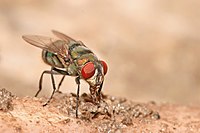
Photo from wikipedia
Abstract The main aim of the current study was to perform a genetic analysis of two live body weight and two carcass composition traits in purebred UK-born Texel, Suffolk and… Click to show full abstract
Abstract The main aim of the current study was to perform a genetic analysis of two live body weight and two carcass composition traits in purebred UK-born Texel, Suffolk and Charollais lambs separately in order to produce future across country evaluations. The two live body weight traits considered were early-life weight (40–85 days of age) and scan weight (121–180 days of age), and the two carcass composition traits were muscle depth and fat depth. Only records from lambs born between 2010 and 2017 were used in the present study resulting in a total of 132,490 records from 55,155 lambs spread over 374 flocks being included for further analysis. An animal linear mixed model was used to derive (co)variance components for the studied traits, for each breed individually. Fixed effects included in the model were contemporary group, dam age at lamb’s birth, dam age at first lambing, a birth type by rearing type of the lamb interaction and a sex by age of the lamb at measurement interaction. Random effects included in the model were the animal additive genetic effect, the dam maternal effect, the litter environment effect and the residual effect. The dam maternal effect applied only to the analysis of early-life weight. Heritability estimates ranged from 0.12 to 0.30 for the two live body weight traits across the three breeds. The two carcass composition traits had heritability estimates ranging from 0.18 to 0.42. Strong positive genetic correlations were observed between all traits analysed. Results from the present study show that genetic variation still exists within breeds for the traits studied indicating that even after over 30 years of genetic selection within the UK they are still amenable to genetic improvement. Furthermore, significant differences in genetic parameters between breeds were observed, especially for carcass composition traits, indicating that genetic evaluations should be calculated separately for each breed.
Journal Title: Small Ruminant Research
Year Published: 2021
Link to full text (if available)
Share on Social Media: Sign Up to like & get
recommendations!